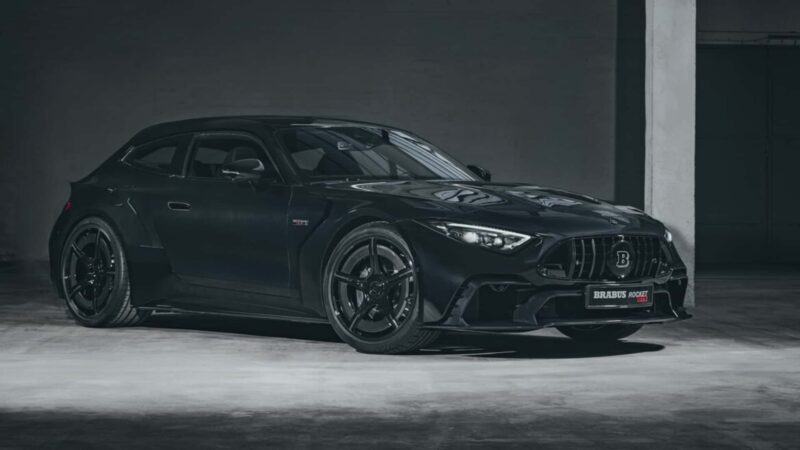Never have I thought that a roadster like the Mercedes SL could be reimagined as a shooting brake. But as it’s been proven time and time again, nothing is impossible with Brabus.
Believe it or not, the Rocket GTS you see here originally started life as a Mercedes-AMG SL63 S E Performance.
You might have a hard time recognising it, as the soft top convertible roof has been replaced with a fixed roof, a sloping windscreen, and a tailgate.
What’s even more impressive is that the entire body—including the bonnet, bumpers, side panels, and roof—is made from carbon fibre.
In addition, the front apron, rear diffuser, aerodynamic blades on the Monoblock P Platinum Edition wheels, and exhaust tips are also crafted from this lightweight material to keep the shooting brake’s weight in check.
Speaking of weight, Brabus has not disclosed the overall weight, but we’d bet it is considerably lighter than the donor car, which weighs a hefty 2,195 kg.
According to the company, the Rocket GTS has undergone wind tunnel testing to ensure stability at speeds of 300 km/h and above.
The front apron helps reduce lift, while the flat roof, ducktail spoiler, and aggressive rear diffuser design contribute to increased downforce at high speeds.
On top of that, the large air intake directs airflow towards the radiator and front brakes for improved cooling.
Like the SL 63, the interior of the Rocket GTS can still accommodate four passengers in a 2+2 configuration.
Moreover, by eliminating the convertible roof mechanism, Brabus has succeeded in creating a larger cargo space behind the cabin, making it much more practical than the SL.
As with most of Brabus’s designs, the cockpit has been upgraded with carbon fibre trim, Alcantara upholstery, soft leather, and the Brabus logo. Needless to say, customers have the freedom to choose from a vast array of options.
True to its name, the Rocket GTS is powered by a hybrid twin-turbo V8 engine from the SL 63, which has been enlarged from 4.0 litres to 4.5 litres. When combined with the electric motor on the rear axle, it boasts a whopping 1,000 PS and 1,820 Nm!
However, to protect the transmission, Brabus has decided to limit the torque to a more manageable 1,620 Nm.
Even so, this car can still accelerate from 0 to 100 km/h in 2.6 seconds, 0 to 200 km/h in 9.5 seconds, and 0 to 300 km/h in 23.6 seconds. Brabus says the top speed is electronically limited to 317 km/h, suggesting that it could go even faster.
